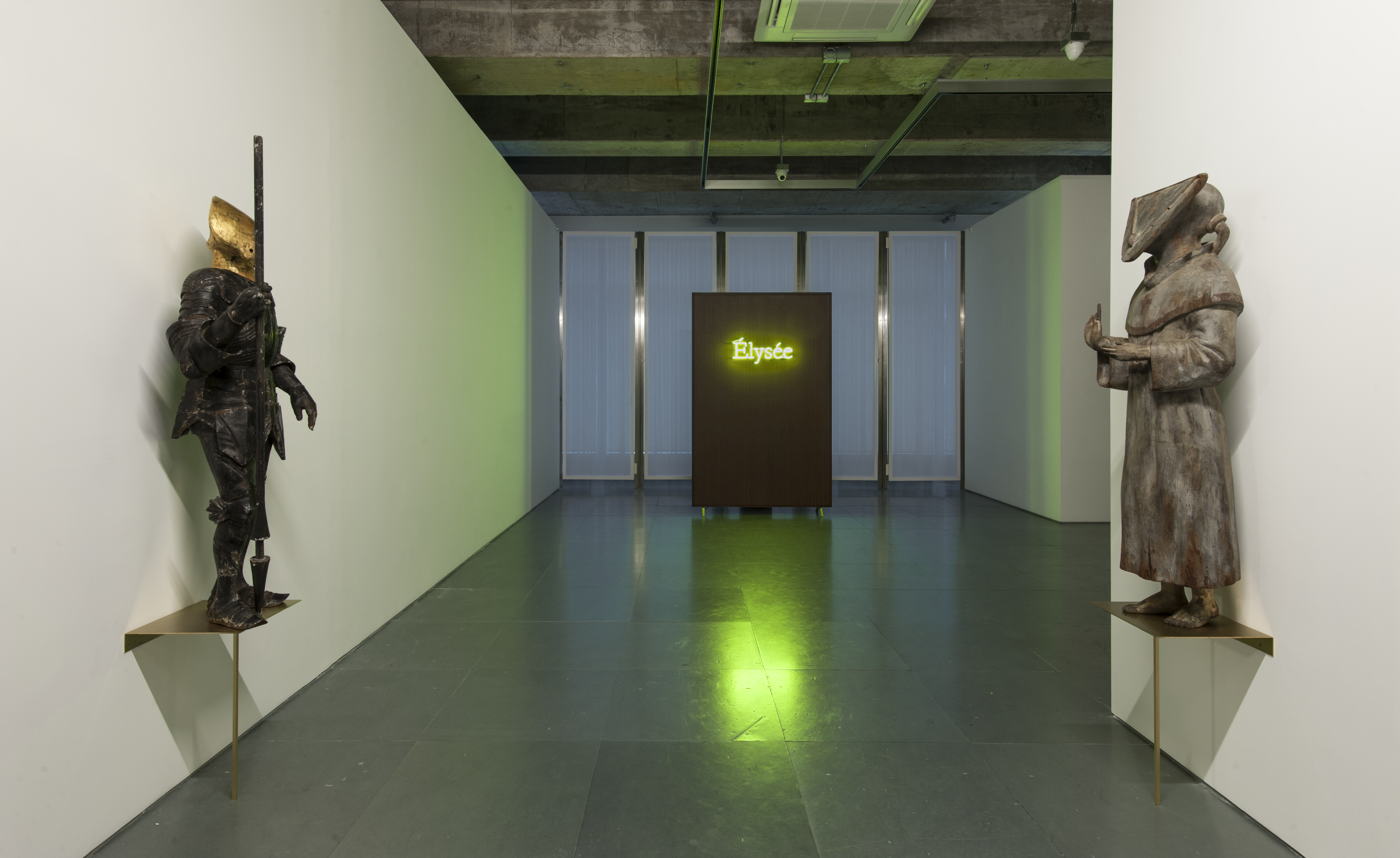Shows
Laurent Grasso’s "Élysée"


Material configurations of power and wealth in Europe have often manifested in beautiful forms. From Pope Julius II’s commission for Michelangelo’s Sistine Chapel fresco to the Palace of Versailles, individuals and institutions have sought to surround themselves with structures that reflect and uphold their influence. It is not surprising then, that gold, glossy textures and polished surfaces make up the visuals of Laurent Grasso’s latest exhibition, “Élysée,” at Edouard Malingue Gallery in Hong Kong. The French conceptual artist offers a reflection on the aesthetics of power through his signature mode of storytelling that blends imagery from multiple histories, temporalities and geographies.
Grasso’s ongoing fascination with supernatural phenomena is present upon entry to the gallery, where viewers are greeted by two hybrid sculptures that mix medieval iconography with the sculptural forms of Japan’s Neolithic Jômon period. Chevalier DOGÜ (2016) and Prêtre JÔMON (2015) are referred to as “ancient aliens,” that is, evidence of extraterrestrial life hidden in plain site in ancient myths. The amalgamation of these seemingly unconnected icons raises questions surrounding the linear timeframes in which history is documented and sets out a superstitious tone that is carried throughout the show.


At first glance the series of oil paintings “Studies into the Past” could have been pulled straight from 18th-century France. Aristocratic aesthetics of authority appear in a depiction of the Salon Doré, the French Presidential office. Gold leaf traces the intricate interiors of the room, while boiled oil paint that gradually deepens in color has given it its authentic look. Although the regal subject matter seems to command serious contemplation, underneath it the playful deception of Grasso as con artist is at work, as he subtly places himself inside European traditions of painting. In one work, spherical monoliths sit in a barren landscape, bringing to mind stories of crop circles and UFOs. They are in fact the United States government’s surveillance network of radar domes used during the Cold War. Conspiracy theorists have stereotypically been thought of as fanatics, loudly espousing elaborate ideas about governments and other mysterious events throughout history, but here Grasso’s method is quiet and cunning. By fusing past techniques with modern depictions of technology the viewer and work alike is suspended in a historical limbo that creates an unsettling atmosphere.
On its own, In Silentio (2016) appears bizarrely cartoonish rather than the foreboding sense that its symbolism denotes. The sculpture, a marble pelican with a ball in its mouth, recreates a fragment of a Vatican fresco signaling secrecy—a key principle of the religious epicenter. Connecting the sphere that blocks the bird’s beak to the spy domes in “Studies of the Past,” viewers may find themselves coerced out of passive observation and activated to join Grasso in the role of conspiracy theorist, drawing somewhat far-reaching links between the various forms of power on display.

Aesthetics of power are also prevalent in the exhibition’s organization and layout. To view Soleil Double (2015), viewers are ushered into a panoptic wooden frame. Two speakers on either side of a screen, and a gold anechoic wall designed to absorb sound, form an immersive, controlled environment in which to view the film. On screen, two rival suns appear over the fascist-era architecture of the Palace of Italian Civilization, originally built in 1935 by Benito Mussolini to exhibit the absolute rule of the state and signal a new phase of nationalism. The focus on the building’s neoclassical Greek sculptures and rationalist arches lit up by the dual suns, bring to mind the former egocentric belief that the earth was the center of the universe around which all other planets revolved.
Visitors discover the source of a spiritual hum of choir voices reverberating throughout the gallery in another film, Élysée (2016). Gold, a visual motif throughout the exhibition, here reaches a crescendo as the Salon Doré—a famously ornate room within the Élysée Palace in Paris—is presented in all its gilded splendor. The steady pan of the camera slowly zooms in on the golden regalia, resulting in a hypnotic, mesmerizing effect interrupted only by the presence of everyday objects (piles of paper work, a telephone, television, etc.) amid the royal architecture. The image of power is diverted for a moment from the historical monarch to the image of the modern-day Republic. The absence of a Presidential figure suggests that true dominance is ultimately beyond the grasp of any one individual. The elaborate architecture of the Salon Doré, then, appears as a stage through which control is acted out, revealing that certain visual forms are not merely inherent products of power, but also producers of it.
Paradoxically, what makes Grasso’s work stand out in this exhibition is his reserved opinion and ambiguous attitude towards the aesthetics of authority. Albeit constructing fictitious images of history and subtly throwing in hints of conspiracy theories, he largely avoids making overt judgments on power and its visual forms. As such, his reflective approach allows for a slow and careful unraveling of bold imagery and themes. Viewers have space to form their own interpretations and further ponder the peculiar images of Grasso’s invented histories.








